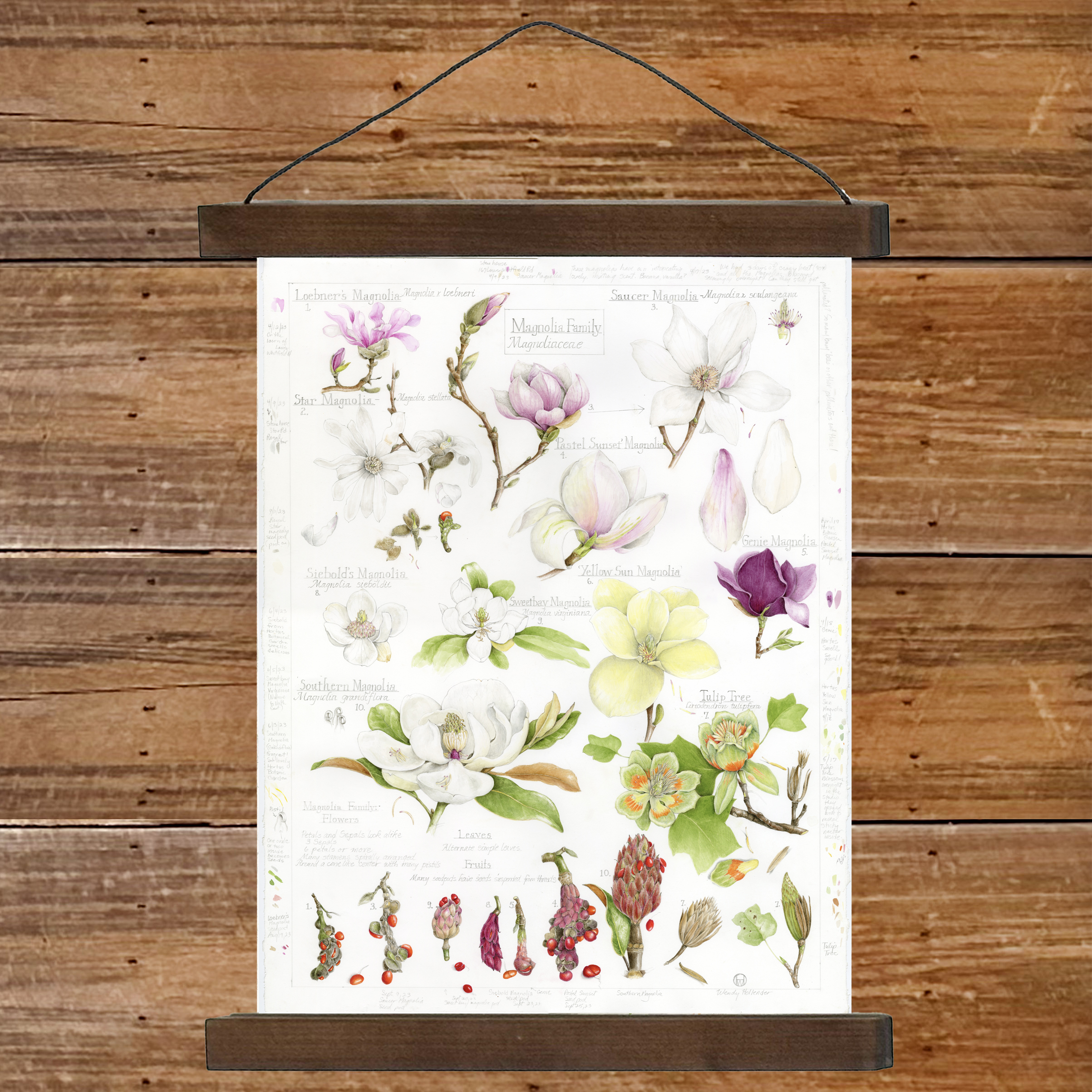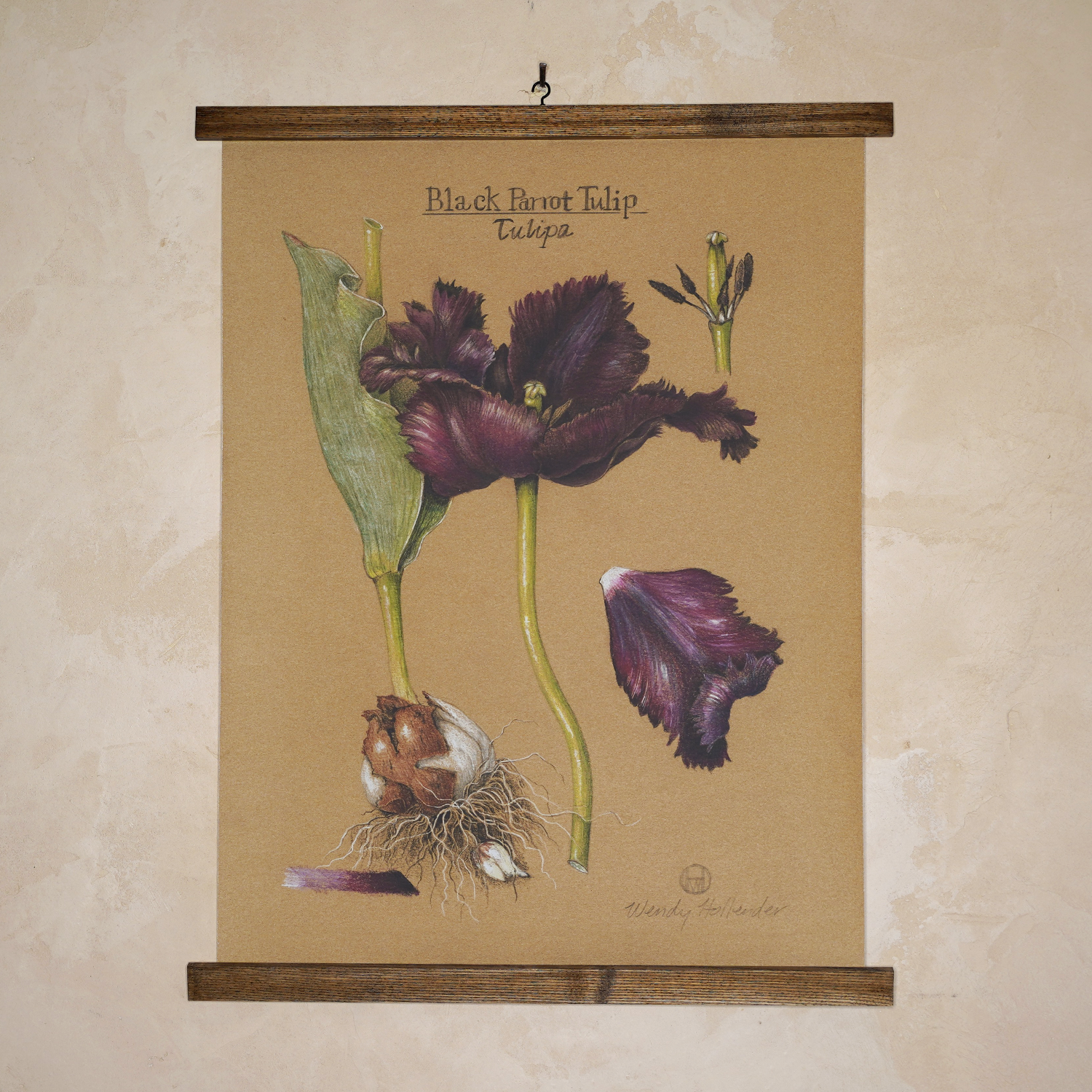Did you know that Chocolate, Cotton, Okra and Hibiscus are all related?!
Plants are classified by their reproductive structures, so plants in the same family have flowers (and other reproductive parts) that look alike, but otherwise, they are free to be their unique (and delicious!) selves.
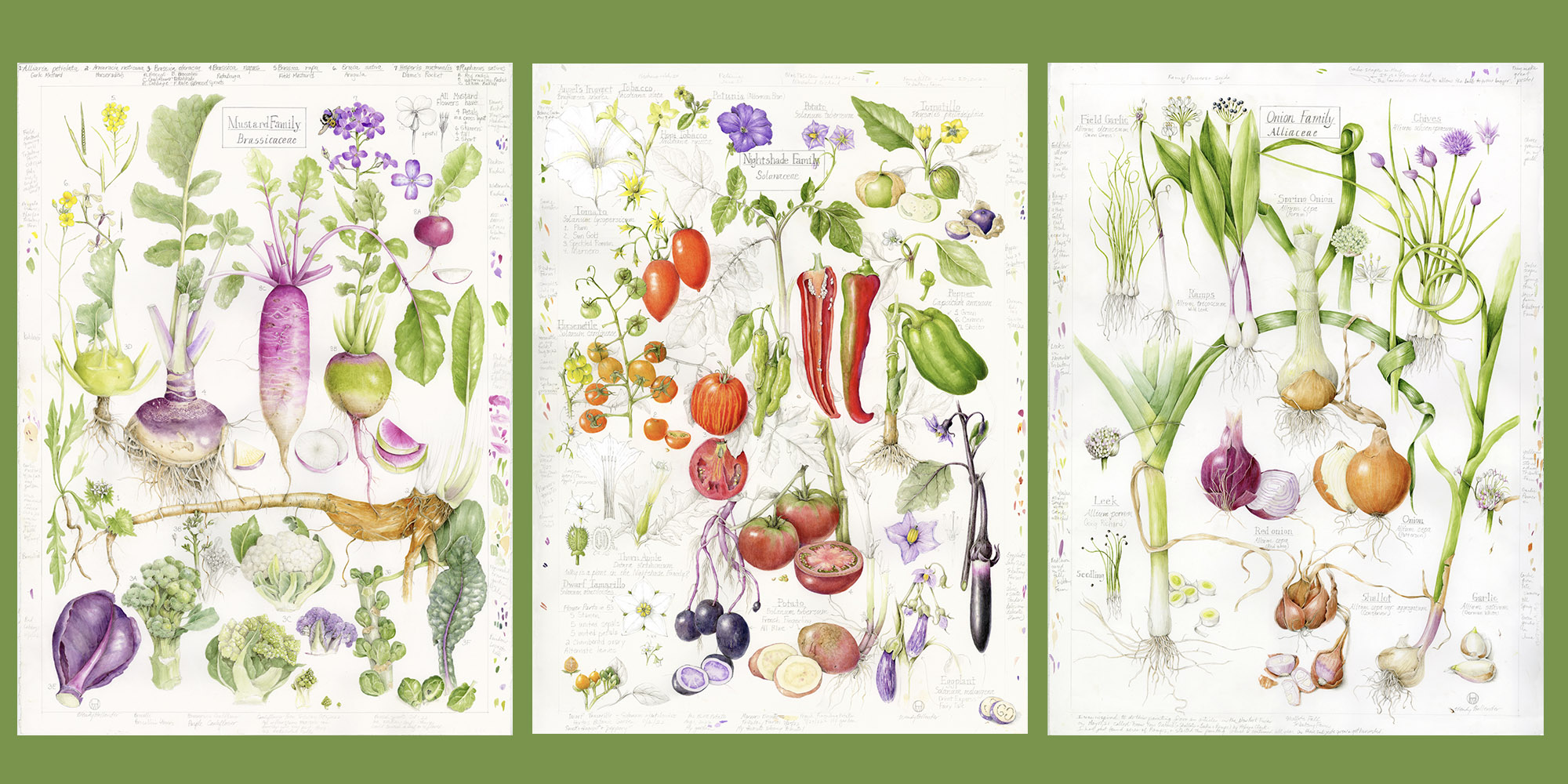
Plant Awareness
The more I draw botanicals, the more I learn about plants. The more I learn about plants, the more I realize how little I knew about them! Since humans developed urban societies, we have diminished our experiences with nature.
When you need food or medicine, do you go outside to forage? For most of us, the answer is no; we go to a store, market, or pharmacy. Because we are removed from witnessing the growth and importance of plants in our local environment, we now find ourselves in “a cyclic process of inattention” known as “plant awareness disparity.” (Source)
This may sound harmless, but humanity’s under-appreciation of plants can have catastrophic consequences, including losing interest in plant conservation, which is vital to both environmental and human health. The good news is that it’s not too late to become plant-aware!
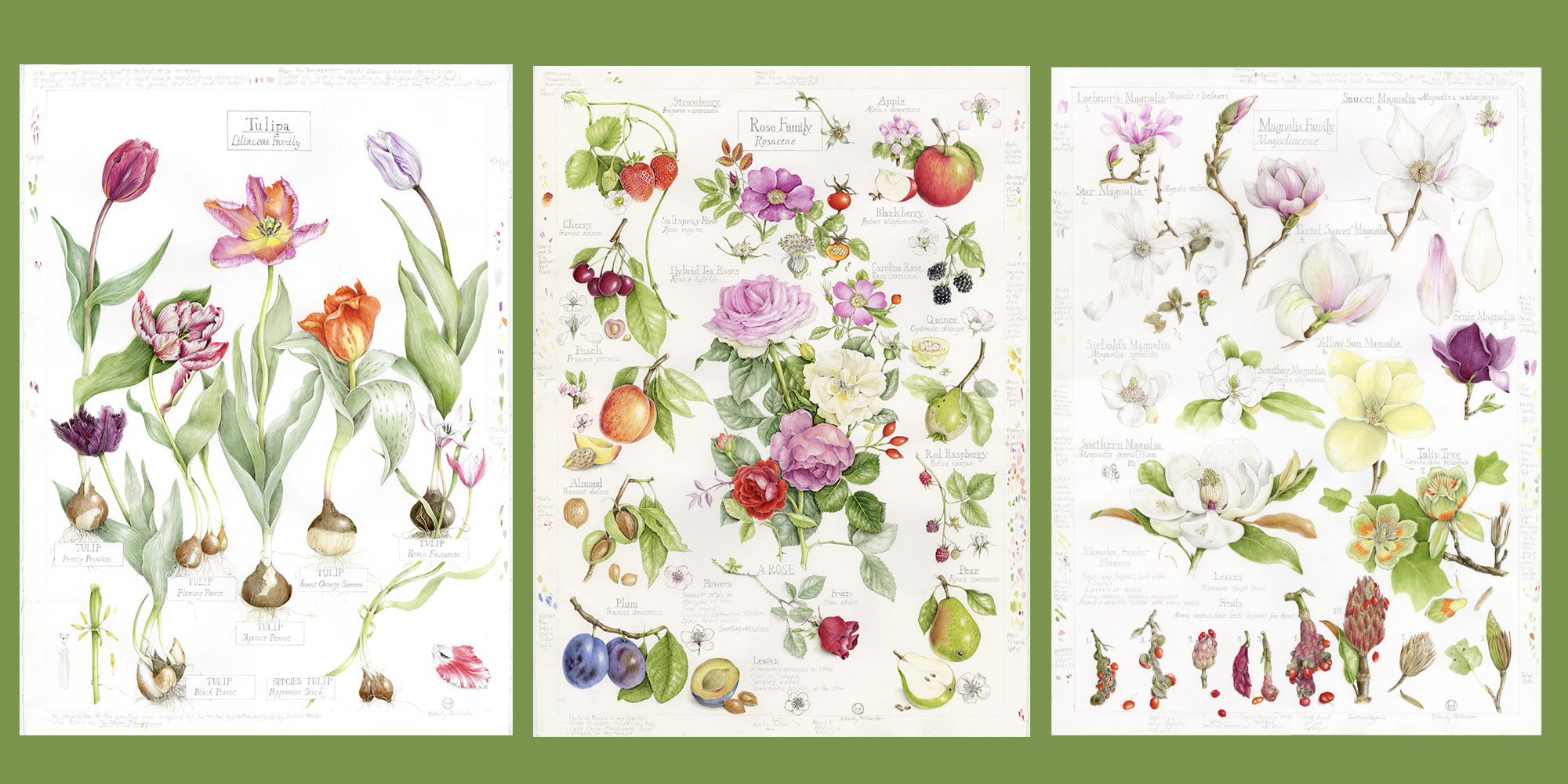
My goal with this series of plant family portraits is to deepen people’s awareness of plants and gain an understanding of plant details. An appreciation for biodiversity is an important part of our wellbeing. May we all delight in nature’s fascinating architecture and colors, appreciate our environment, and how precious it is to protect.
To learn more about identifying plant families (including how to interpret a plant’s Latin name), check out Lesson 8 in The Practice of Botanical Drawing.
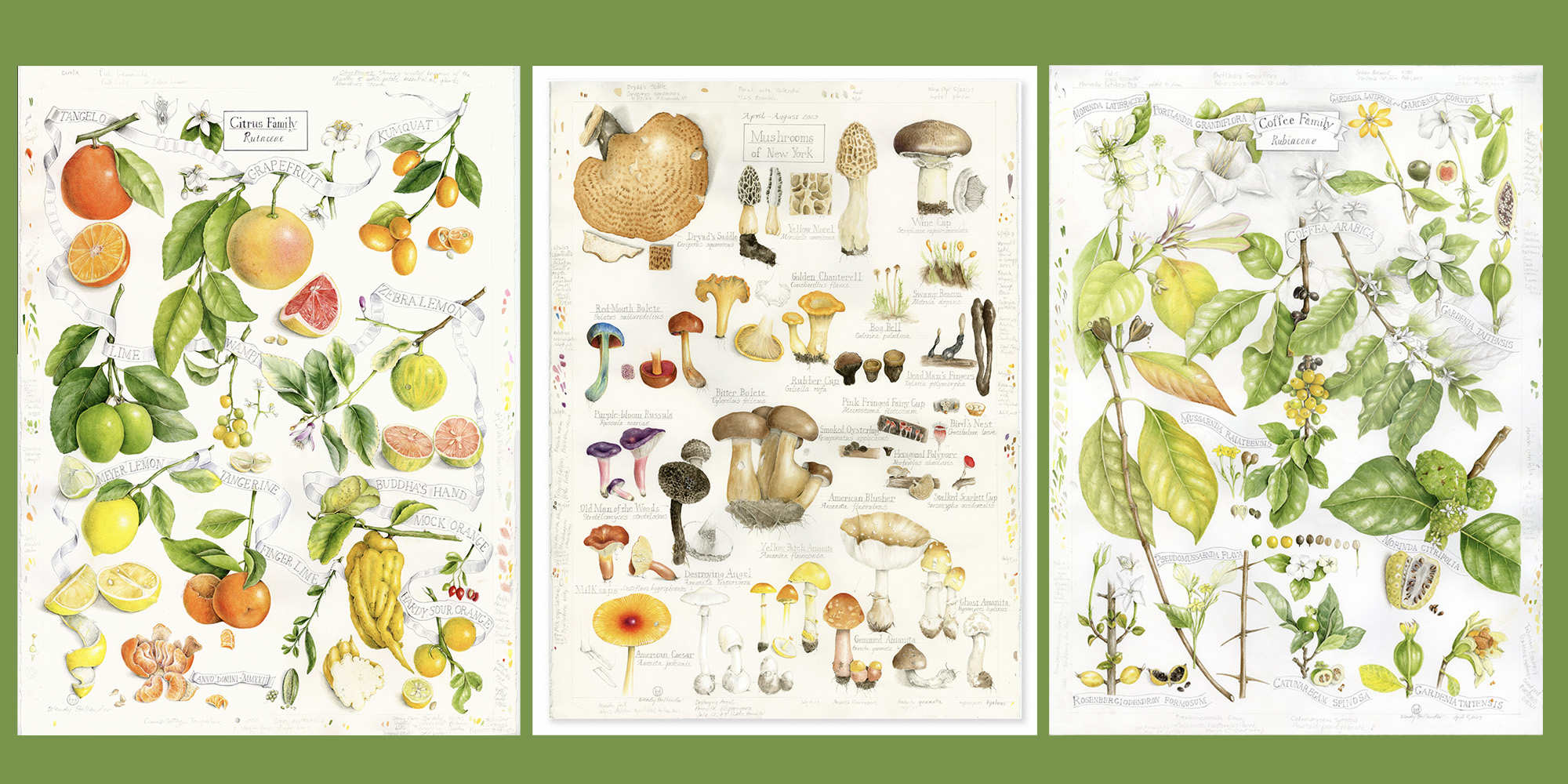
Plant Family Portraits
As I learned more about each plant family, my newest venture became clear – a series of larger paintings (that I am offering as fine art prints) showcasing the similarities and differences between plants in the same families. I included as many species and life cycle stages as I could fit on the page to best illustrate where their similarities begin and end.
These prints are excited to hang with your family! They are available on either acid-free watercolor paper or canvas in three sizes (11″x15″ / 17″x22″ / 24″x32″). Buy Plant Family Portrait Prints here.
Scroll through this post to see each plant family portrait along with its lists of shared family traits and plants included in the painting. (To learn more about a specific family and journey through my discoveries, click on the name below to jump to that section.)
To date (Sept. 2024), I have completed 10 Plant Family Portraits:
1. Onion Family (Alliaceae, sub family of Liliaceae)
2. Nightshade Family (Solanaceae)
3. Citrus Family (Rutaceae)
4. Coffee Family (Rubiaceae)
5. Tulip Family (Tulipa, sub family of Liliacea)
6. Mustard Family (Brassicaceae)
7. Mushrooms of New York 1, April thru July 2023 (Fungi Kingdom)
8. Mushrooms of New York 2, July thru October 2023 (Fungi Kingdom)
9. Rose Family (Rosaceae)
10. Magnolia Family (Magnoliaceae)
Paintings in progress:
11. Cashew Family (Anacardiaceae)
12. Pea Family (Fabaceae)
13. Gourd Family (Cucurbitaceae)
14. Carrot Family (Apiaceae)
15. Sunflower Family (Asteraceae)
16. Amaryllis Family (Amaryllidaceae)
17. Mint Family (Lamiaceae)
18. Mallow Family (Malvaceae)
19. Palm Family (Arecaceae)
20. Grass Family (Poaceae)
21. Fig Family (Moraceae)
22. Soapberry Family (Sapindaceae)
23. Ginger Family (Zingiberaceae)
24. Orchid Family (Orchidaceae)
I plan to complete 24 of these paintings and exhibit them side-by-side. Individually, we can see the similarities and differences between plants in the same family. Together, we can see how the families compare to each other. What do all plants have in common? What do we as humans share across our various families?
How do I choose which families to include?
I have picked many of the common and most useful plants to humans as a starting point. Most are plants we eat, but some families are about the beauty we get from them.
Criteria for this series of Plant Family Portraits
1. Plants in a painting must be part of the same family or sub family.
I am also including the Fungi Kingdom, but those paintings are separated by season, not by family.
2. Use real live plants for reference.
I can use photos to complete a painting if I don’t still have access to the live plant.
3. All subjects are painted on one full page, 22 inches wide by 30 inches high.
The composition and interaction can be determined by what feels right for each family. (The paintings are NOT put together from various drawings and assembled in Photoshop.)
4. Text is included for subject identification.
I can include each plant’s common and scientific name, as well as dates, locations, tastes, etc.
5. Color dabs, test samples, and notes in the margins are part of the painting.
The process is part of the fun!
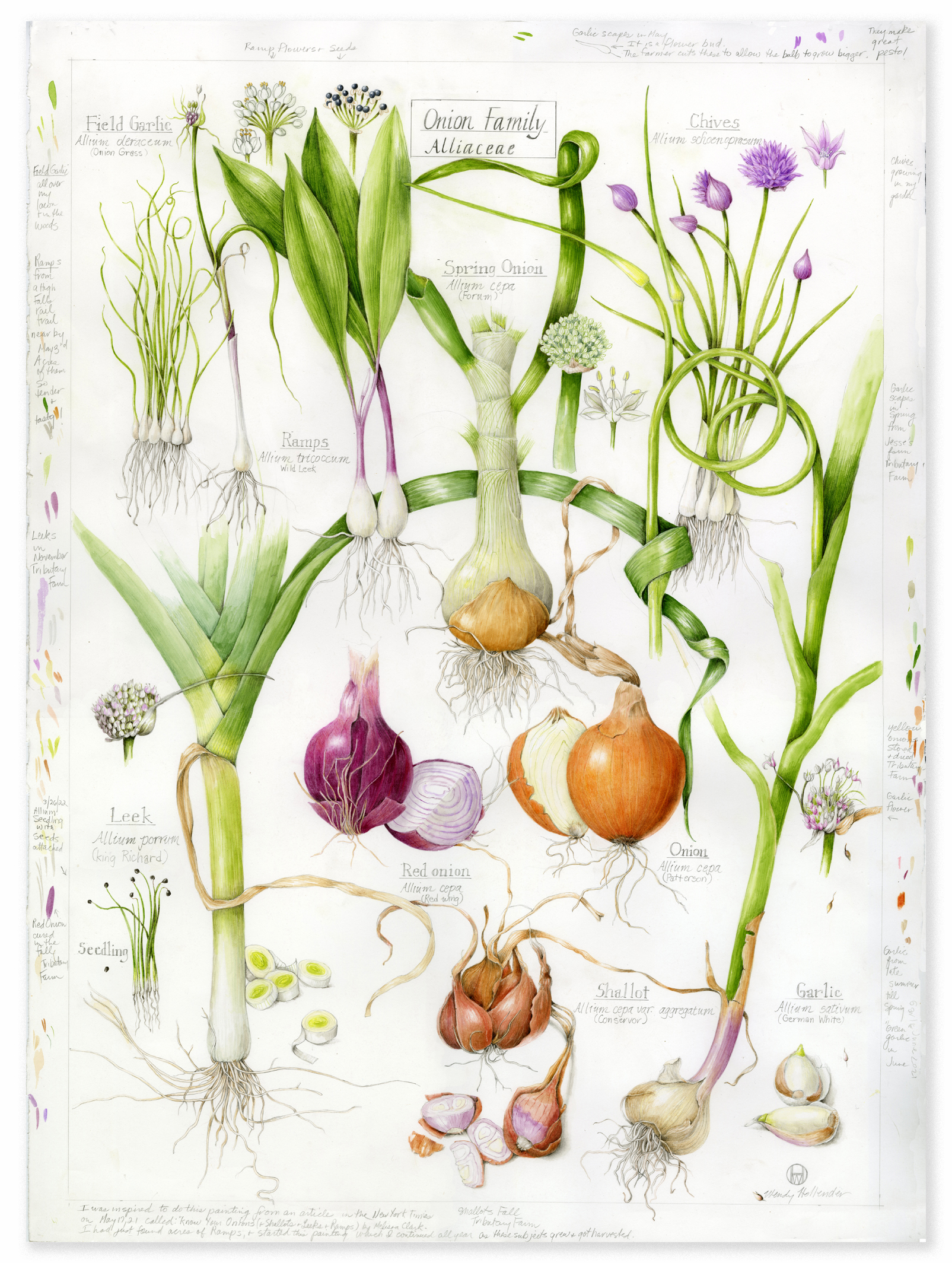
1. Onion Family (Alliaceae, sub family of Liliaceae)
Plants in the Onion Family share these traits:
Flowers
Produced on scapes
6 tepals produced in 2 whorls
6 stamens
Leaves
Pungent
Linear
Bulbs reform annually from the base of the old bulb (most are perennials)
Plants depicted in the Onion Plant Family Portrait:
Shallot (Allium cepa var. aggregatum) (Conservor)
Spring Onion (Allium cepa) (Forum)
Onion (Allium cepa) (Patterson)
Red Onion (Allium cepa) (Red Wing)
Field Garlic (Allium deraceum) (Onion Grass)
Leek (Allium porrum) (King Richard)
Garlic (Allium sativum) (German White)
Chives (Allium schoenoprasum)
Ramps (Allium tricoccum) (Wild Leek)
Learn more about the Onion Family

2. Nightshade Family (Solanaceae)
Plants in the Nightshade Family share these traits:
Flowers
5 stamen
5 united sepals
5 united petals
Leaves
Alternately arranged on stem
Usually feature plant hairs and are sometimes armed with prickles
Fruit
Ovary with 2 chambers
Plants depicted in the Nightshade Plant Family Portrait:
Angel’s Trumpet (Brugmansia arborea)
Pepper (Capsicum annuum)
Green
Carmen
Shishito
Thorn Apple – Jimson Weed (Datura stramonium)
Tobacco (Nicotiana alata)
Hopi Tobacco (Nicotiana rustica)
Petunia – Alderman Blue (Petunia nana compacta)
Tomatillo (Physalis philadelphica)
Dwarf Tamarillo (Solanum abutiloides)
Horsenettle (Solanum carolinense)
Tomato (Solanum lycopersicum)
Plum
Sun Gold
Speckled Roman
Marnero
Eggplant (Solanum melongena)
Orient Express
Fairy Tale
Potato (Solanum tuberosum)
French Fingerling
All Blue
Learn more about the Nightshade Family
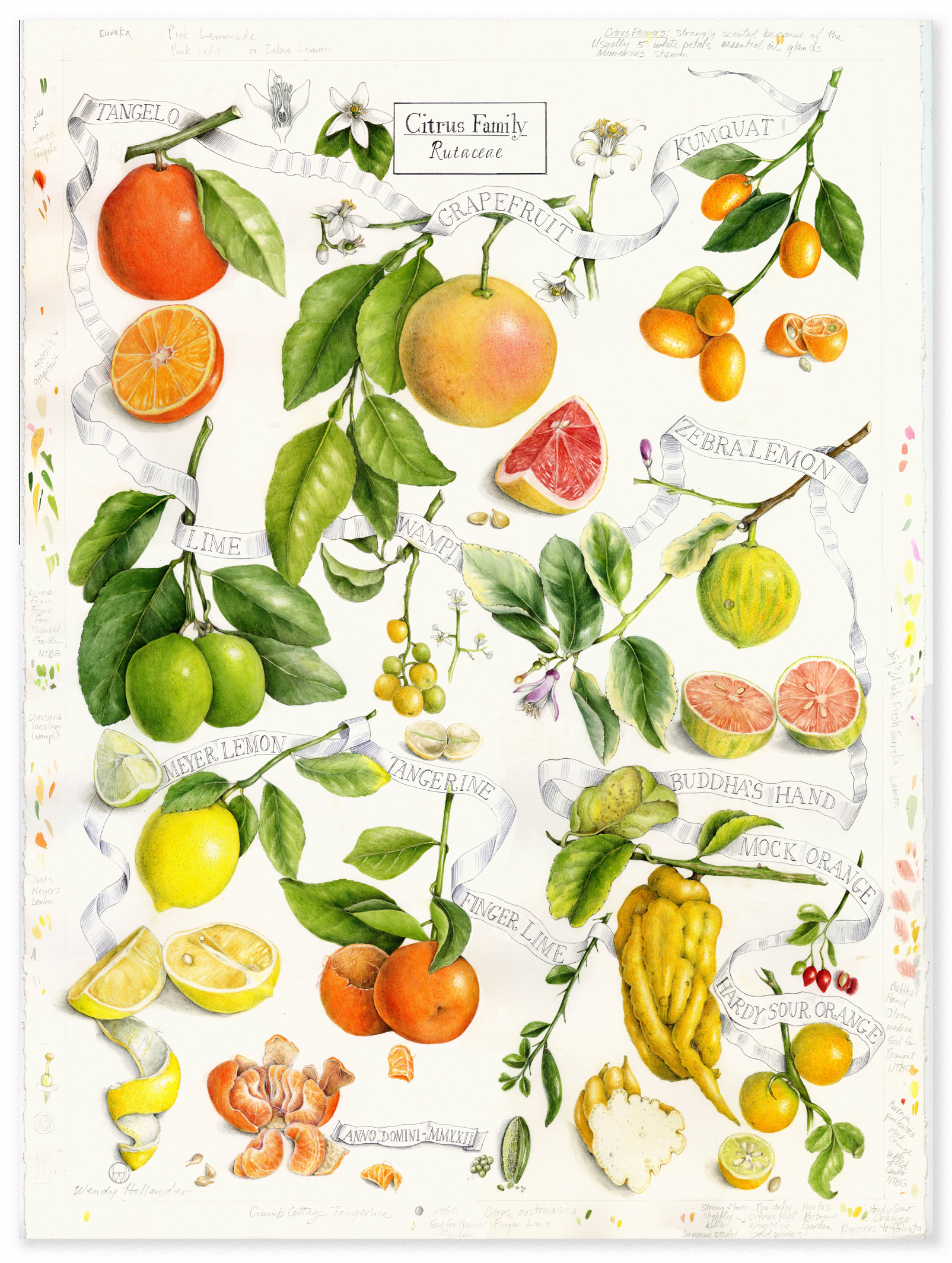
3. Citrus Family (Rutaceae)
Plants in the Citrus Family share these traits:
Leaves
Glossy and oval-shaped
Flowers
5 white petals
Numerous stamen
Fruit
Hesperidium – flesh is divided into segments packed with tiny juice-filled vesicles
Covered with a moderately thick leathery peel/rind studded with fragrant oil glands
Plants depicted in the Citrus Plant Family Portrait:
Lime (Citrus aurantifolia)
Finger Lime (Citrus australasica)
Kumquat (Citrus japonica)
Wampi (Clausena lansium)
Zebra Lemon (Citrus limon variegata)
Buddha’s Hand (Citrus medica var. sarcodactylis)
Meyer Lemon (Citrus × meyeri)
Grapefruit (Citrus x paradisi)
Tangelo (Citrus reticulata x paradisi)
Tangerine (Citrus tangerina)
Mock Orange (Murraya paniculata)
Hardy Sour Orange (Poncirus trifoliata)
Learn more about the Citrus Family

4. Coffee Family (Rubiaceae)
Plants in the Coffee Family share these traits:
Leaves
Elliptical and waxy
Oppositely arranged along the stem
Often feature prominent venation
Fruit (known as “coffee cherry”)
1 or 2 seeded drupe
Plants depicted in the Coffee Plant Family Portrait:
Catunaregam Spinosa (Mountain Pomegranate)
Coffea Arabica (Arabic Coffee)
Gardenia Cornuta (Horned Gardenia)
Gardenia Latifolia (Indian Boxwood)
Gardenia Taitensis (Tahitian Gardenia)
Morinda Citrifolia (Noni)
Morinda Latibractea
Mussaenda Raiateensis (Pacific Mussaenda)
Rosenbergiodendron Formosum (Blackberry Jam Fruit)
Portlandia Grandiflora (Bell Flower)
Pseudomussaenda Flava (Dwarf Mussaenda)
Learn more about the Coffee Family

5. Tulip Family (Tulipa, sub family of Liliacea)
Plants in the Tulip Family share these traits:
Leaves
2-3 thick bluish green leaves at the base of the plant
Flowers
3 petals and 3 sepals
6 stamens
3-lobed ovary terminated by a sessile 3-lobed stigma
Plants depicted in the Tulip Plant Family Portrait:
Species Tulip – Peppermint Stick
Tulip – Apricot Parrot
Tulip – Black Parrot
Tulip – Flaming Parrot
Tulip – Giant Orange Sunrise
Tulip – Pretty Princess
Tulip – Rem’s Favourite
Learn more about the Tulip Family
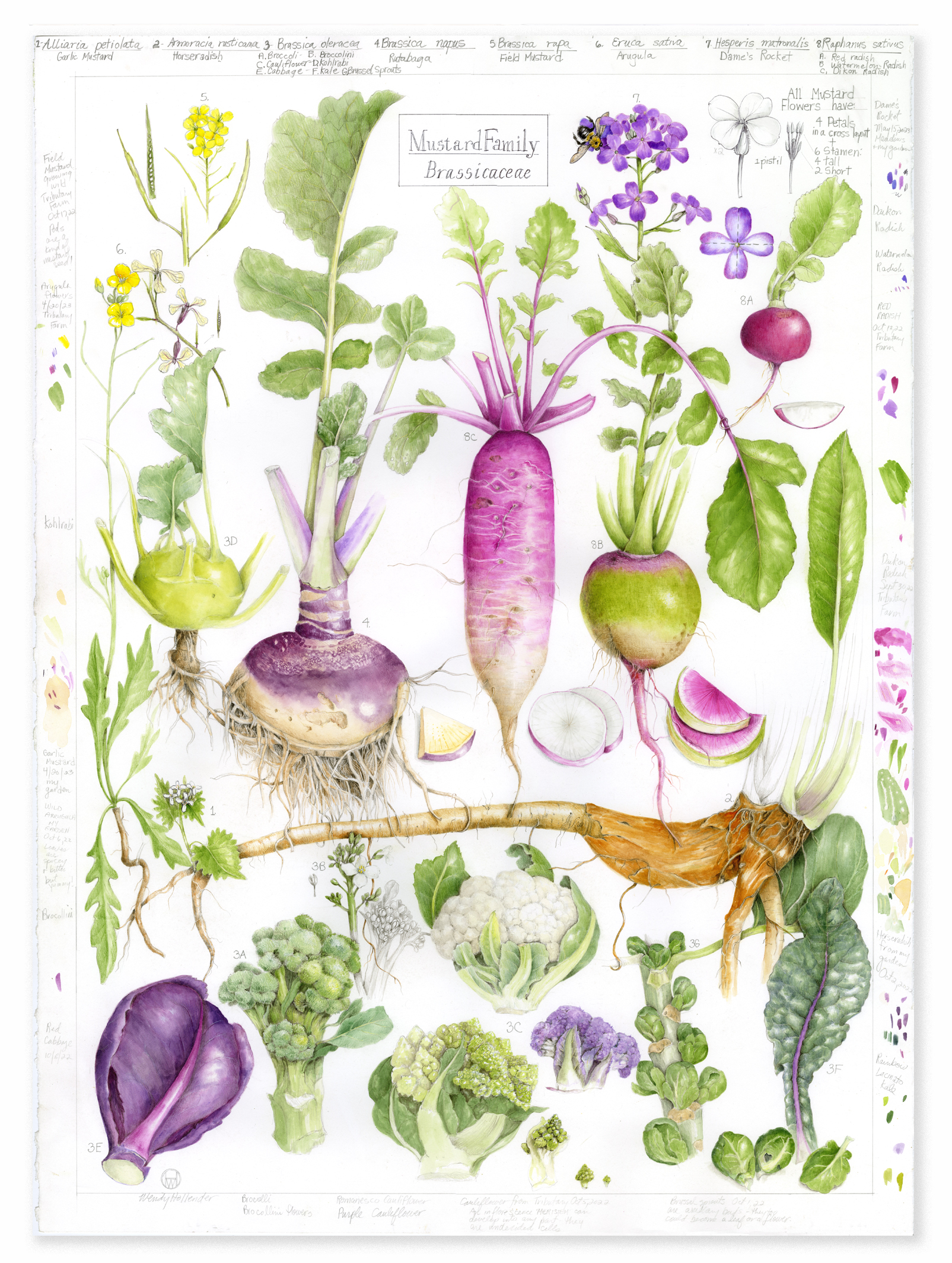
6. Mustard Family (Brassicaceae)
Plants in the Mustard Family share these traits:
Flowers
4 petals and 4 sepals
6 stamens (4 tall and 2 short)
2-chambered ovary
Seeds are produced in dry podlike fruits with a partition between the halves
Plants depicted in the Mustard Plant Family Portrait:
Alliaria petiolata (Garlic Mustard)
Armoracia rusticana (Horseradish)
Brassica oleracea
Broccoli
Broccolini
Romanesco Cauliflower
Purple Cauliflower
Kohlrabi
Red Cabbage
Rainbow Lacinato Kale
Brussel Sprouts
Brassica napus (Rutabaga)
Brassica rapa (Field Mustard)
Eruca sativa (Arugula)
Hesperis matronalis (Dame’s Rocket)
Raphanus sativus var. longipinnatus
Red Radish
Watermelon Radish
Daikon Radish
Learn more about the Mustard Family
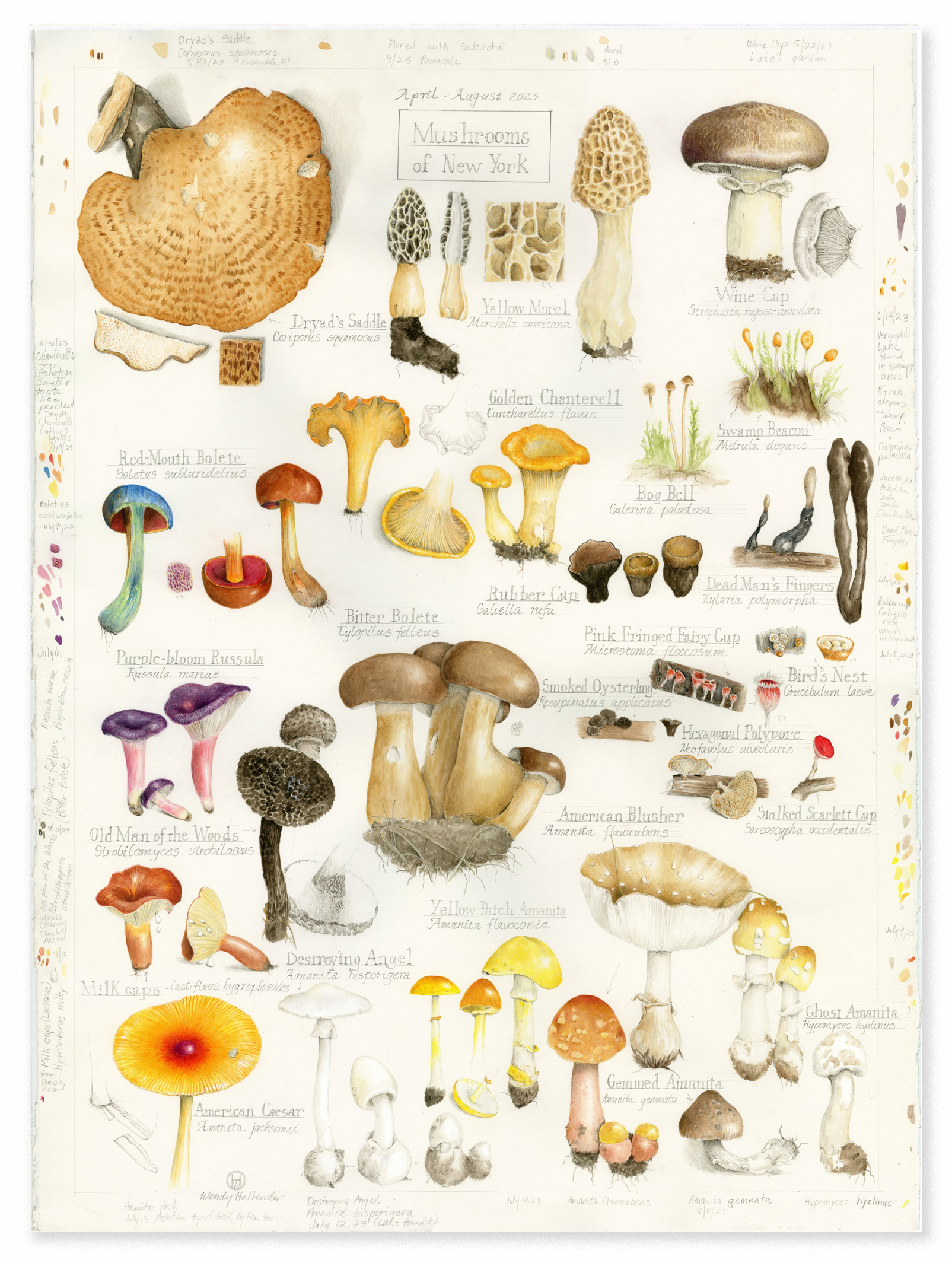
7. Mushrooms of New York – April thru August 2023 (Fungi Kingdom)
Luke Sarrantonio (a brilliant, local fungi education, foraging, and cultivation consultant) has been guiding me to the best secret mushroom hideouts and teaching me about how mushrooms grow and develop once they are above ground. I ran out of space on my first painting in July, so I started a second painting to showcase the mushrooms in New York through October. (Find Luke on Instagram @mycophilicorganism)
Fungi depicted in this Family Portrait:
American Blusher (Amanita flavorubens)
Yellow Patch Amanita (Amanita flavoconia)
Destroying Angel (Amanita bisporigera)
American Caesar (Amanita jacksonii)
Gemmed Amanita (Amanita gemmata)
Red-Mouth Bolete (Boletus subluridelius)
Golden Chanterell (Cantharellus flavus)
Dryad’s Saddle (Ceriporus squamosus)
Bird’s Nest (Crucibulum laeve)
Bog Bell (Galerina paludosa)
Rubber Cup (Galiella rufa)
Ghost Amanita (Hypomyces hyalinus)
Milk Caps (Lactifluus hygrophoroides)
Pink Fringed Fairy Cup (Microstoma floccosum)
Swamp Beacon (Mitrula elegans)
Yellow Morel (Morchella americana)
Hexagonal Polypore (Neofavolus alveolaris)
Smoked Oysterling (Resupinatus applicatus)
Purple-bloom Russula (Russula mariae)
Stalked Scarlett Cup (Sarcoscypha occidentalis)
Old Man of the Woods (Strobilomyces strobilaceus)
Wine Cap (Stropharia rugoso-annulata)
Bitter Bolete (Tylopilus felleus)
Dead Man’s Fingers (Xylaria polymorpha)
Learn more about Fungi (part 1)
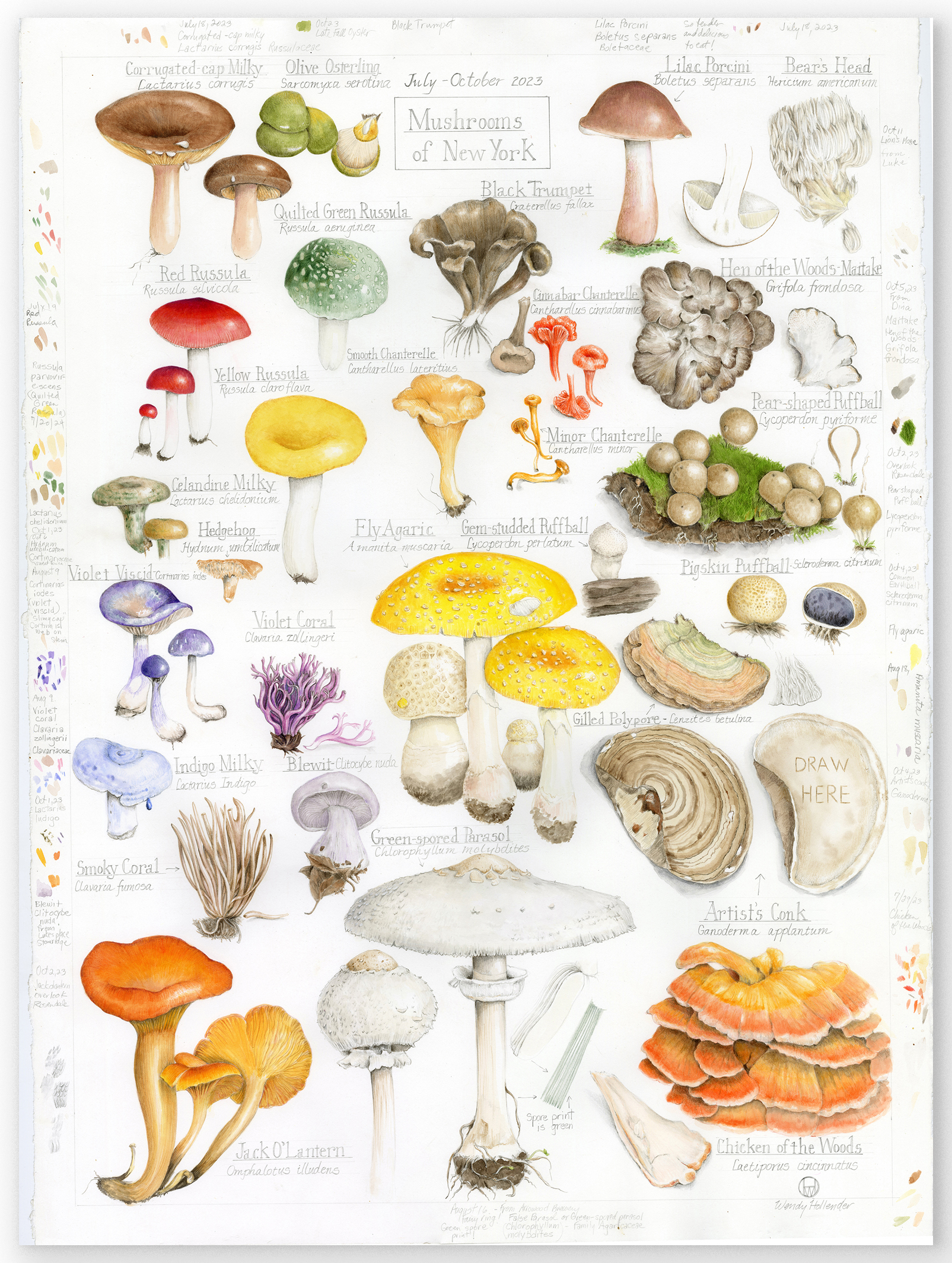
8. Mushrooms of New York 2 – July thru October 2023 (Fungi Kingdom)
Fungi depicted in this Family Portrait:
Fly Agaric (Amanita muscaria)
Lilac Porcini (Boletus separans)
Cinnabar Chanterelle (Cantharellus cinnabarinus)
Smooth Chanterelle (Cantharellus lateritius)
Minor Chanterelle (Cantharellus minor)
Green-spored Parasol (Chlorophyllum molybdites)
Smoky Coral (Clavaria fumosa)
Violet Coral (Clavaria zollingeri)
Blewit (Clitocybe nuda)
Violet Viscid (Cortinarias iodes)
Black Trumpet (Craterellus fallax)
Artists’ Conk (Ganoderma applantum)
Hen of the Woods-Maitake (Grifola frondosa)
Bear’s Head (Hericium americanum)
Hedgehog (Hydnum umbilicatum)
Celandine Milky (Lactarius chelidonium)
Corrugated-cap Milky (Lactarius corrugis)
Indigo Milky (Lactarius Indigo)
Chicken of the Woods (Laetiporus cincinnatus)
Gilled Polypore (Lenzites betulina)
Gem-studded Puffball (Lycoperdon perlatum)
Pear-shaped Puffball (Lycoperdon pyriforme)
Jack O’Lantern (Omphalotus illudens)
Quilted Green Russula (Russula aeruginea)
Yellow Russula (Russula claroflava)
Red Russula (Russula silvicola)
Olive Osterling (Sarcomyxa serotina)
Pigskin Puffball (Scleroderma citrinum)
Learn more about Fungi (part 2)

9. Rose Family (Rosaceae)
Plants in the Rose Family share these traits:
Flowers
Separate petals in multiples of five
Five sepals
Numerous distinctive stamen
Often fused pistils
Smelling delicious!
Leaves
Alternately arranged on stem
Oval in shape
Serrated edges
Sometimes prickles on the stem
Fruit
Often edible (and delicious!)
Plants depicted in the Rose Plant Family Portrait:
Quince (Cydonia oblonga)
Strawberry (Fragaria x ananassa)
Apple (Malus domestica)
Cherry (Prunus avium)
Plum (Prunus domestica)
Almond (Prunus dulcis)
Peach (Prunus persica)
Pear (Pyrus communis)
Carolina Rose (Rosa carolina)
Hybrid Tea Roses (Rosa x hybrida)
Queen Elizabeth – Grandiflora Rose
Julia Child – Floribunda Rose
Miracle on the Hudson
Saltspray Rose (Rosa rugosa)
Blackberry (Rubus alleghenienses)
Red Raspberry (Rubus idaeus)
Learn more about the Rose Family

10. Magnolia Family (Magnoliaceae)
Plants in the Magnolia Family share these traits:
Flowers
Petals and sepals look alike
3 sepals
6 petals or more
Many stamens spirally arranged around a cone like center with many pistils
Leaves
Alternate simple leaves
Fruit
Seed Cones have seeds suspended from threads
Plants depicted in the Magnolia Plant Family Portrait:
Loebner’s Magnolia – Magnolia x loebneri
Star Magnolia – Magnolia stellata
Saucer Magnolia – Magnolia x soulangeana
Pastel Sunset Magnolia – Magnolia ‘Pastel Sunset’
Genie Magnolia – Magnolia x soulangeana ‘Genie’
‘Yellow Sun Magnolia’- Magnolia ‘Yellow Sun’
Siebold’s Magnolia – Magnolia sieboldii
Sweetbay Magnolia – Magnolia virginiana
Southern Magnolia – Magnolia grandiflora
Tulip Tree – Liriodendron tulipifera
Learn more about the Magnolia Family
Click Here to Purchase Plant Family Portraits
Hang your prints without the hassle! Click here for our Effortless Wooden Frames.
